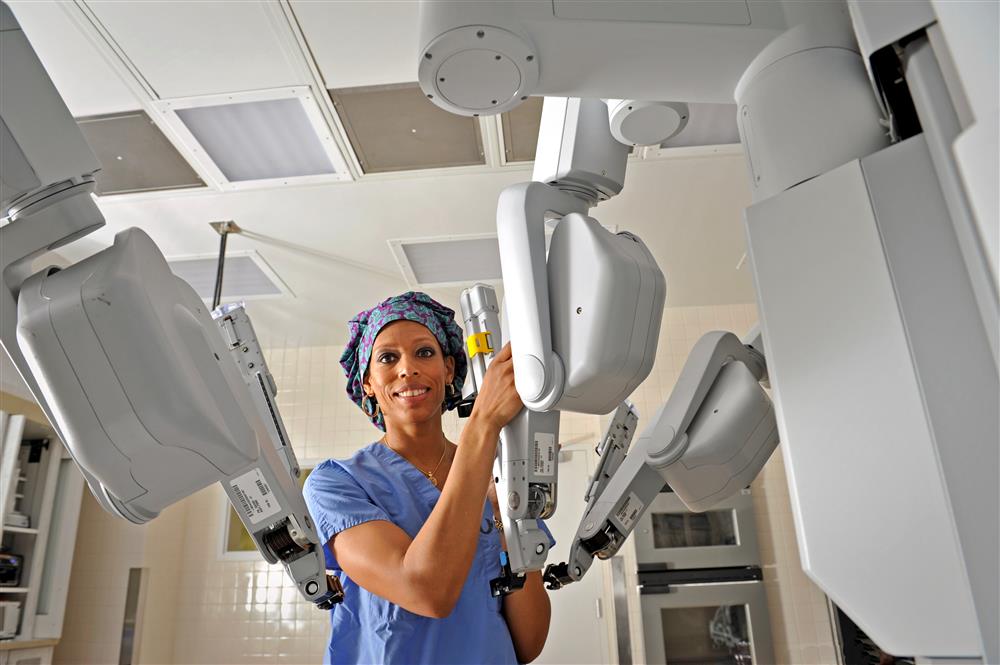UMHC head, neck cancer surgeons use robotic surgery to treat tumors

Patients in the early stages of select head and neck cancers have a less-invasive option for surgery through University of Mississippi Health Care.
Two surgeons in the Department of Otolaryngology and Communicative Sciences have been certified to use transoral robotic surgery (TORS) to treat a variety of benign and select malignant tumors of the mouth, voice box, tonsil, tongue and other parts of the throat. Dr. Gina Jefferson and Dr. Kristen Otto, both assistant professors of otolaryngology, have completed the certification process through M.D. Anderson Cancer Center. They use the only FDA-approved robotic surgical system for TORS, the da Vinci Surgical System.
In many cases, surgery offers the greatest chance of survival; however, traditional surgical methods often require an almost ear-to-ear incision across the throat or splitting the jaw, resulting in speech and swallowing complications for patients.
The minimally invasive approach, which accesses the surgical site through the mouth, has been shown to improve long-term swallowing function and to reduce risk of airway obstruction while speeding up the recovery time.
"It improves access to the tumor and the ability to reconstruct the defect," Jefferson said. "We can eliminate the need for a tracheotomy, and patients can usually start an oral diet shortly after surgery."
Also, this minimally invasive approach to certain head and neck tumors has shortened hospitalizations from 7-10 days to 3-4 days.
William Cole, a 61-year-old retiree, was able to talk about his experience just days after Jefferson removed cancerous tissue from his throat using robotic surgery. His primary care physician had referred him to the G. V. "Sonny" Montgomery Veterans Affairs Medical Center in December for a medical problem that Cole believed was related to his allergies.
"They checked my throat and saw a white substance," Cole said. "Turned out it was malignant. Dr. Jefferson happened to be working in the VA that day, and she came to see me.
"God moves in mysterious ways. Needless to say, they forgot about my allergies."
Cole said he had surgery Dec. 27 and was able to go home by New Year's Eve.
Jefferson said the interest in less-invasive surgical options for patients grew out of a 1990 larynx study in the VA hospitals.
"They looked at maintaining the function of the organ with advanced disease and how to keep it intact while eliminating the cancer with induction chemotherapy and radiation," she said. "In some cases, however, there was still a need to completely remove the voice box and create a permanent hole, or stoma, in the neck."
In 2009, the FDA approved the minimally invasive surgical approach developed by head and neck surgeons at the University of Pennsylvania School of Medicine. Jefferson said the procedure isn't recommended in all early stage cancers because each patient's anatomy is unique.
More than 28,000 Americans were diagnosed with head and neck cancer in 2004, according to the American Cancer Society. Jefferson said about 5 percent of all cancers are head and neck malignancies; however, this type of cancer is common in Mississippi's population because of the heightened use of smokeless tobacco and cigarettes.
Head and neck tumor treatments often involve a combination of surgery, radiation therapy and chemotherapy. The robotic surgery could potentially eliminate or reduce radiation and chemotherapy, Jefferson said.
She also said the advantage of robotic surgery is that it provides a three-dimensional view of the surgical area, which allows for more precise dissection, and 540-degree movement.
Jefferson said it's important for primary care physicians to recognize the symptoms of patients with head and neck cancer to catch the disease as early as possible. If the following symptoms are detected, an adult patient should be evaluated by a head and neck cancer specialist: a neck mass lasting for more than two weeks, hoarseness for more than two weeks, one-sided ear or throat pain, a lesion of the mouth that doesn't heal with antibiotics, unintentional weight loss and coughing of blood.
"If detected early enough, the quality of life for a patient can be greatly improved," Jefferson said.


